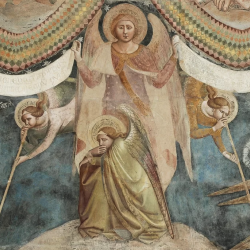Inclusion in the World Heritage List

In December 1987, the Piazza del Duomo in Pisa became part of the World Heritage List (WHL).
The UNESCO World Heritage Center conferred the title of World Heritage Site of Piazza del Duomo in 1987, on the occasion of the eleventh Conference of the World Heritage Committee
It is the sixth Italian cultural Site included in the list in chronological order and meets, according to the UNESCO World Heritage Center, to the following criteria, which contribute to determining its Outstanding Universal Value:
- (i) Artistically unique because of its spatial design, the Piazza del Duomo contains four absolute architectural masterpieces: the cathedral, the baptistery, the bell tower and the Campo Santo. Within these monuments are such world-renowned art treasures as the bronze doors and mosaics of the cathedral, the pulpits in the baptistery and cathedral, the frescoes of the Campo Santo, and many others.
- (ii) The monuments of the Piazza del Duomo considerably influenced the development of architecture and monumental arts at two different times in history. First, from the 11th century up to 1284, during the epitome of Pisa's prosperity, a new type of church characterized by the refinement of polychrome architecture and the use of loggias was established. The Pisan style that first appeared with the Cathedral can be found elsewhere in Tuscany (notably at Lucca and Pistoia), but also within the Pisan maritime territory, as shown in more humble form by the "pieve" in Sardegna and Corsica. Later, during the 14th century, architecture in Tuscany was dominated by the monumental style of Giovanni Pisano (who sculpted the pulpit of the Cathedral between 1302 and 1311), a new era of pictorial art - the Trecento - was ushered in after the epidemic of the Black Death (Triumph of Death, a fresco by Bonamico Buffalmacco at the Campo Santo, c. 1350).
- (iv) The group of monuments of the Piazza del Duomo, composed of typical religious buildings constructed for distinct and specific functions, constitutes an outstanding example of medieval Christian architecture.
- (vi) It was at the Cathedral of Pisa that Galileo Galilei (1564-1642), observing the oscillations of the bronze chandelier created by Battista Lorenzi, discovered at the age of 19 the theory of isochronism of small oscillations, a prelude to his pioneering work on dynamics. From the top of the campanile, he conducted experiments, which led him to formulate the laws governing falling bodies. Two of the principal buildings of the Piazza dei Miracoli are thus directly and tangibly associated with a decisive stage in the history of physical sciences.
The UNESCO World Heritage Center, therefore, recognizes the Pisan Site as an architectural unicum that has inspired, over the centuries, the works carried out in the City and in Tuscany. The monuments in Piazza del Duomo influenced the development of much of the sacred architecture later on, especially in the use, for decorative purposes, of polychrome marbles and loggias. In the City, there is the Church of Santa Maria della Spina, the Church di San Michele in Borgo, the Church di San Pietro in Vinculis, and the Church di San Paolo all'Orto; while the parish Churches in Sardinia and Corsica, for example, bear witness to the great territorial resonance of Pisa, starting from year 1000, as a maritime republic.
